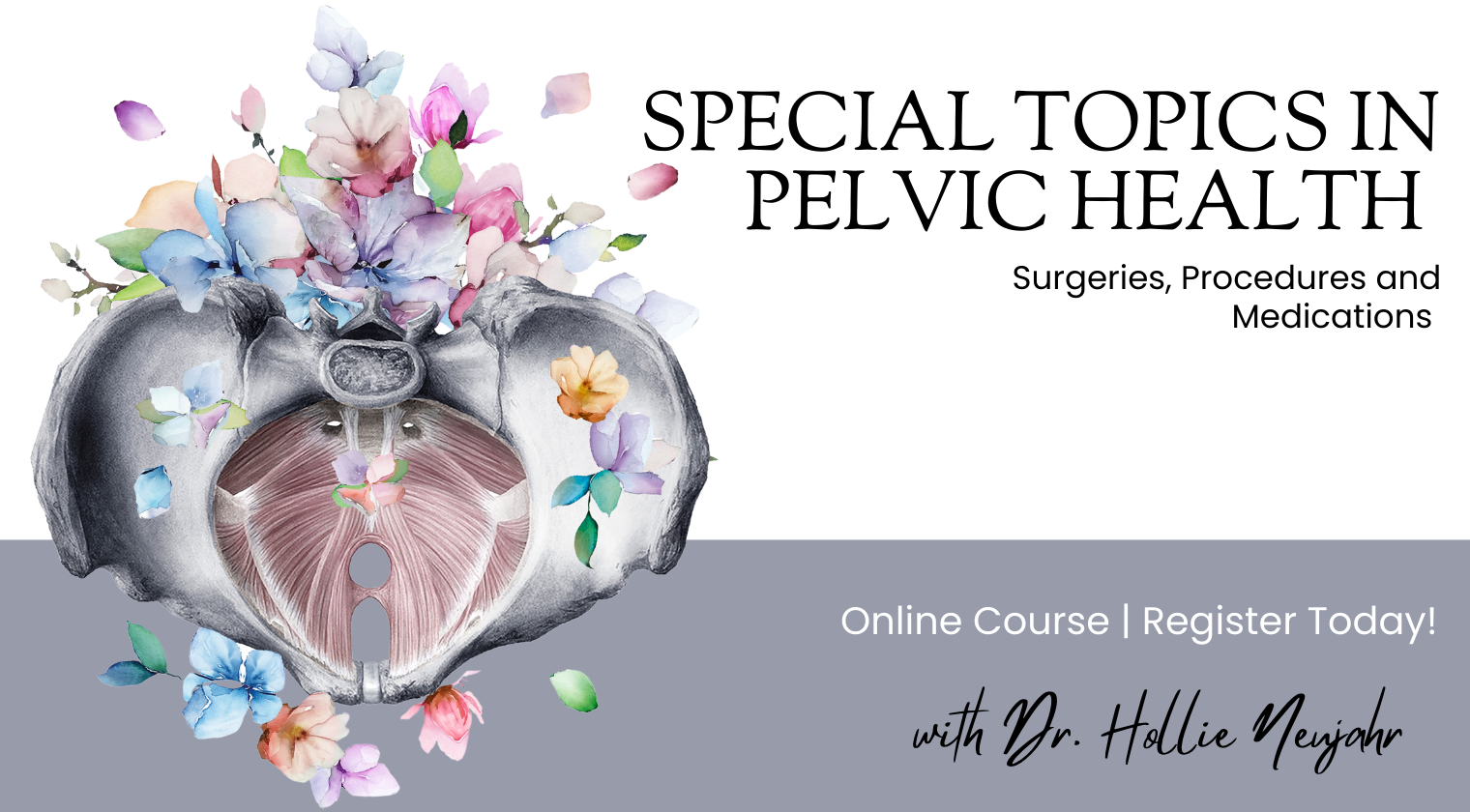One on One Mentoring
Mentoring prices vary if you are mentoring in a group or with more than one person, and email Hollie directly for details on rates.
For in-person mentoring please contact Hollie to schedule. Online scheduling is for virtual mentoring only!
Our Courses
Special Topics in Pelvic Health: Pediatrics, Adolescents, and Guide to Pelvic Health Tools
This chapter adds foundational knowledge specific to pediatrics and adolescents so that you are able to better build your pelvic skill set and modify your approaches as necessary to these demographics. In addition, it overviews various devices and tools we can use as pelvic health physical therapists and makes suggestions on how to integrate these into the plan of care for the best outcome.
Special Topics in Pelvic Health: Surgeries, Procedures and Medications
In Special Topics in Surgeries, Procedures, and Medications, you will learn about the most commonly observed in each aspect of the pelvic health specialty. You will learn the foundations of what each surgery and procedure mean and how to integrate what this means into providing the best pelvic health plan. You will also learn about the most frequently prescribed medications, in general, in pelvic health and how that can impact care.
Special Topics in Pelvic Health: Bowel and Prolapse
This chapter expands on gastrointestinal anatomy and physiology, as well as defining frequently observed bowel problems we see in pelvic health. Examples of these are anal fissures, fecal incontinence, rectal pain, constipation, and IBS. The second part of this chapter expands on defining prolapse, ligamentous support in the pelvic floor, and research-based suggestions on how to examine and treat factors causing pelvic organ prolapse.
Special Topics in Pelvic Health: Neurobiology and Applications to Pelvic Pain
Pelvic Health Neurobiology and Applications to Pelvic Pain dives deeper into the root of the problem in helping patients with various types of pelvic pain. With an entire section dedicated to myofascial trigger points, the theory behind myofascial trigger points, and approaches toward learning to manually release and gain insights on dry needling the pelvic floor muscles. The second part of this course chapter will dive deeper into pelvic floor neuroanatomy and emphasize issues that arise with pudendal nerve problems and how to approach basic issues associated with pelvic symptoms associated with issues in the neuroanatomy. The last section of this chapter will review common causes of chronic pelvic pain, medical diagnoses attached to issues with chronic pelvic pain, and present research and practical suggestions on how to approach these patients effectively, and safely, and build a foundational skill set.
Foundations of Pelvic Floor: Anatomy and Physiology, Problems and Examination
The Integrated Ortho-Pelvic Approach discusses multiple orthopedic contributors to pelvic floor problems and how we can combine various examination processes (low back, hip, therapeutic neuroscience education, and more) to provide well rounded treatment for our pelvic health patients. This course also discusses the sacrum, sacroiliac joint problems, and assessment from a research based perspective. At the end of this course the learner will be more confident in diagnosing, prioritizing, organizing, and accomplishing treatment for pelvic health patients that includes the entire body.
Pelvic Health During Pregnancy: The Fourth Trimester, and the Functional Postpartum Period
Foundational Obstetrics and Gynecology for the physical therapist introduces the pelvic health specialist to proper baseline information to build a foundation in the treatment of patients who are pregnant and/or postpartum. The course will cover proper terminology, medical expectations, and cycles associated with pregnancy. In addition, there are special sections dedicated to presenting and interpreting the research for diastasis recti and helping to learn the best approach toward several aspects of postpartum care.
The Integrated Orthopedics and Pelvic Health Approach
Foundations of Pelvic Floor Anatomy and Physiology, Problems and Examination covers all aspects of learning your pelvic health foundations. Chapter one will focus on anatomy, examination, physiology, and function as well as introduce the gastrointestinal system, pudendal nerve and female reproductive system. The second part of this chapter overviews frequently observed pelvic health problems we frequently evaluate and treat as pelvic health specialists and lays the foundation for future more advanced chapters that isolate these topics and go into more detail around these problems. Lastly, this chapter is the lecture portion of learning the techniques to evaluate external perineum, anorectal, internal vaginal, and internal rectal and provides guidance on anatomy, and prepares students to move on for hands-on lab training with a mentor or in a professional lab setting.
Special Topics in Male Pelvic Health and Oncology
This chapter covers male pelvic health and how to properly integrate oncology into treatment of pelvic health clients. This will start by overviewing male pelvic floor anatomy, physiology, pelvic health problems, and make suggestions on evaluation and treatment based on evidence and clinical experience of the instructor. The second part of this course overviews the lymphatic system and how treatment of oncology diagnoses impacts pelvic health and patient care. It helps the provider consider mind-body in plan of care as well as emphasizing that the patient is a lead on the team, and cancer survivorship is the priority in care.
Pelvic Health: the Unabridged Series (Complete Course)
Pelvic Health: The Unabridged Series is a course that provides the entire lecture and informational foundation to start a pelvic health practice. It includes vaginal and rectal education, prolapse, orthopedic integration in the pelvic floor, education on male patients, and introductions to pediatrics and adolescents. It also includes special topics on procedures, setting up home treatment tools and programs, and medications often prescribed for pelvic health. It does not include labs as this is virtual and lecture only. Each course participant will meet with the instructor and determine the lab needs they have. They are able to schedule these as needed and at the student’s convenience. The Pelvic Health: Unabridged Series is meant to provide the theoretical framework to become a pelvic health physical therapist in a broad sense to increase safety and confidence, as well as success when transitioning into this specialty.








